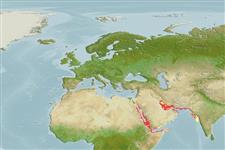Common names from other countries
Environment: milieu / climate zone / depth range / distribution range
Ecologia
marinhas associadas(os) a recifes. Tropical; 30°N - 10°N
Western Indian Ocean: known only from the Red Sea and the Gulf of Aden.
Tamanho / Peso / Idade
Maturity: Lm ? range ? - ? cm
Max length : 6.7 cm SL macho/indeterminado; (Ref. 527)
Espinhos dorsais (total) : 1; Raios dorsais (total) : 29 - 31; Espinhos anais: 0; Raios anais : 27 - 28; Vértebras: 19. Head and body brown; relatively large, black branchial blotch from mid-gill slit to rear border of eye; dusky blotch around eye continued onto forehead and around spinous dorsal base; dark brown iris; pale dusky brown lips. Large pelvic fin rudiment, narrowly attached to posterior margin of ventral flap. Midbody scales with 1-7 spinules, not closely packed; elongate spinules on posterior half of body. Scale spinules on posterior half of body of male very prominent, scale ridge rugosities developing at about 55-65 mm SL.
Occurs in shallow coral reefs to depths of 10 m or more.
Ciclo de vida ou comportamento de acasalamento
Maturities | Reprodução | Spawnings | Egg(s) | Fecundities | Larvas
Hutchins, J.B., 1986. Review of the monacanthid fish genus Pervagor, with descriptions of two new species. Indo-Pac. Fish. (12):35 p. (Ref. 527)
Status na Lista Vermelha da UICN (Ref. 130435)
CITES (Ref. 128078)
Not Evaluated
Ameaça para os humanos
Harmless
Uso pelos humanos
Ferramentas
Relatórios especiais
Baixar XML
Fontes da internet
Estimates based on models
Preferred temperature (Ref.
115969): 25.5 - 29.4, mean 27.9 (based on 120 cells).
Índice de diversidade filogenética (Ref.
82804): PD
50 = 0.5039 [Uniqueness, from 0.5 = low to 2.0 = high].
Bayesian length-weight: a=0.01995 (0.00943 - 0.04220), b=2.93 (2.75 - 3.11), in cm Total Length, based on LWR estimates for this (Sub)family-body shape (Ref.
93245).
Nível Trófico (Ref.
69278): 2.9 ±0.4 se; based on size and trophs of closest relatives
Resiliência (Ref.
120179): Elevada, tempo mínimo de duplicação da população menor que 15 meses (Preliminary K or Fecundity.).
Fishing Vulnerability (Ref.
59153): Low vulnerability (10 of 100).
